
Creative DIY Cat Tree Ideas for Every Home
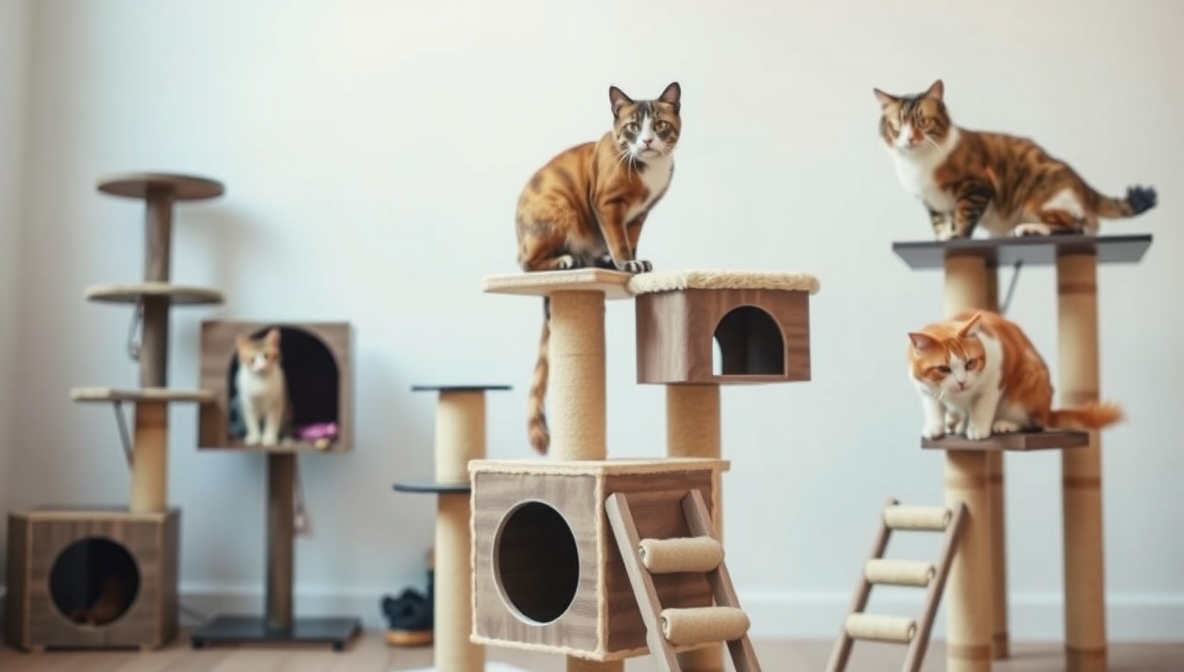
Cats crave vertical territory. They leap, climb, perch, and nap in high places, all while surveying their kingdom with regal flair. A well-built cat tree offers more than entertainment—it gives your feline friend a safe space to scratch, hide, and stretch without ruining your furniture. Buying a pre-made tree can be expensive and bland. That’s where your creativity comes in.
Scraps of wood, sisal rope, carpet remnants, and some imagination can turn your home into a feline paradise. Every pet has a different personality, and their furniture should reflect that. A sleek modern climber suits a minimalist home, while a rustic log-based tower blends perfectly with a cozy cabin vibe. Wall-mounted shelves, multi-level jungle gyms, or repurposed ladders can each become a unique haven for cats to explore.
A DIY cat tree isn’t just a fun weekend project—it becomes a personalized structure built with love. Dive into ideas that are functional, stylish, and tailored to your cat’s quirks. Start building something both of you will enjoy for years. Let the sawdust fly and tails swish with excitement
DIY Cat Tree Ideas: Fun and Easy Projects for Your Feline Friend
Cat trees give cats a place to climb, scratch, and rest. Buying one can cost a lot. Making your own saves money and lets you customize it to your space and your cat’s needs. Plus, building a cat tree can be fun and satisfying.
Here, find 10 easy DIY cat tree ideas. Each idea has a list of materials and simple steps to help you build it yourself. No need for special skills. Use these ideas to create a cozy playground for your cat.
Materials and Basic Tools Needed for DIY Cat Trees
Before starting, gather some basic materials:
-
Wooden boards or plywood
-
PVC pipes or sturdy cardboard tubes
-
Carpet pieces or fabric
-
Sisal rope (for scratching)
-
Screws and nails
-
Glue (wood glue or hot glue)
-
Foam or cushions (for comfort)
-
Drill or screwdriver
-
Saw (hand saw or electric)
-
Stapler or upholstery tacks
Keep safety in mind. Use sandpaper to smooth rough edges. Secure all parts well to avoid wobbling.
1. Simple Wooden Cat Tree with Platforms
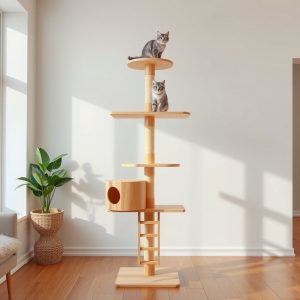
A basic wooden cat tree with a few platforms is a great start. Cats love climbing and resting on different levels.
Materials:
-
Wooden boards (1” thick)
-
Screws
-
Carpet pieces or fabric
-
Sisal rope
Steps:
-
Cut wooden boards into squares or rectangles for platforms.
-
Attach vertical wooden posts to hold platforms at different heights.
-
Wrap sisal rope around one or two posts for scratching.
-
Cover platforms with carpet or fabric using glue or staples.
-
Secure all parts with screws.
This tree is easy to build and fits any room size. Add or remove platforms to suit your space.
2. PVC Pipe Cat Tree with Hanging Toys
PVC pipes make a lightweight, strong frame. Adding hanging toys gives your cat extra fun.
Materials:
-
PVC pipes and connectors
-
Carpet or fabric
-
Rope
-
Small cat toys or balls
-
Hot glue
Steps:
-
Cut PVC pipes into desired lengths for frame posts and platforms.
-
Assemble pipes with connectors to form a sturdy base and several levels.
-
Wrap carpet pieces around platforms and glue them in place.
-
Tie rope or string to the frame and hang small toys.
-
Add sisal rope on parts of the pipes for scratching.
This tree is modern and easy to move. Toys encourage play and exercise.
3. Cardboard Cat Tree with Boxes and Tunnels
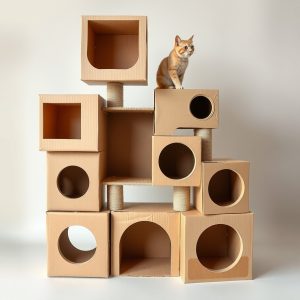
Cardboard is cheap and easy to shape. Cats love tunnels and hiding spots.
Materials:
-
Large cardboard boxes
-
Utility knife
-
Glue or tape
-
Fabric or carpet pieces
-
Markers (optional, for decorating)
Steps:
-
Cut holes in the sides of boxes to create entrances and exits.
-
Stack boxes in an interesting shape and glue or tape them together.
-
Line inside boxes with fabric or carpet for comfort.
-
Add smaller boxes as tunnels or lookout spots.
-
Decorate with markers if desired.
Cardboard cat trees are light, easy to replace, and great for cats who like cozy spaces.
4. Wall-Mounted Cat Tree with Shelves
Wall-mounted trees save floor space and look sleek. Cats enjoy climbing high.
Materials:
-
Wooden shelves
-
Wall anchors and screws
-
Carpet or fabric
-
Sisal rope (optional)
Steps:
-
Measure and mark spots on the wall for shelves at different heights.
-
Secure shelves firmly using wall anchors and screws.
-
Cover shelves with carpet or fabric for grip.
-
Wrap sisal rope on wall-mounted poles if possible.
-
Arrange shelves so cats can jump between them easily.
This idea works well for small rooms. It turns your wall into a cat playground.
5. Tree Branch Cat Tree with Natural Look
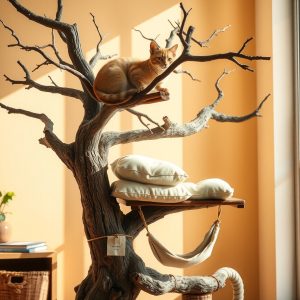
Use real tree branches for a natural climbing experience.
Materials:
-
Thick, sturdy tree branches
-
Wooden base board
-
Screws and brackets
-
Carpet or fabric
-
Sisal rope
Steps:
-
Clean and dry branches well. Remove bark if needed.
-
Attach branches vertically or at angles to a wooden base using screws and brackets.
-
Wrap sisal rope around branches to create scratching spots.
-
Add small carpeted platforms between branches.
-
Check stability before letting cats climb.
This tree blends with nature and feels very real to cats.
6. Ladder Style Cat Tree for Easy Climbing
Cats enjoy climbing ladders. This design combines steps and platforms.
Materials:
-
Wooden slats or boards
-
Screws and nails
-
Carpet pieces or fabric
-
Sisal rope
Steps:
-
Build a ladder frame with wooden slats spaced evenly.
-
Attach platforms at the top and middle of the ladder.
-
Wrap ladder rails or one side with sisal rope.
-
Cover platforms with carpet or fabric.
-
Secure the tree so it doesn’t tip over.
A ladder tree is simple, lightweight, and great for older cats who need easier climbs.
7. Multi-Level Cat Tree with Hideaway Boxes
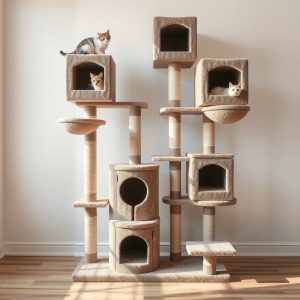
Cats like places to hide and rest. This design mixes open platforms and enclosed boxes.
Materials:
-
Wooden boards
-
Screws and nails
-
Carpet or fabric
-
Sisal rope
Steps:
-
Build a wooden frame with multiple levels.
-
Attach small wooden boxes on some levels as hideaways.
-
Cover platforms and inside boxes with soft carpet.
-
Wrap sisal rope on vertical posts.
-
Add cushions or blankets inside boxes for comfort.
This tree keeps cats entertained and relaxed at the same time.
8. Hammock Style Cat Tree with Hanging Bed
Cats love hammocks. This style hangs a soft bed between two supports.
Materials:
-
Wooden frame or PVC pipes
-
Strong fabric for hammock
-
Screws and hooks
-
Rope or straps
Steps:
-
Build a simple frame with two vertical supports.
-
Attach hooks on each side at the same height.
-
Make a hammock using strong fabric and rope loops.
-
Hang hammock from hooks, making sure it holds weight.
-
Add carpet or padding under the hammock for extra comfort.
A hammock tree gives cats a cozy, swinging spot to relax.
9. Rotating Cat Tree with Spinning Platform
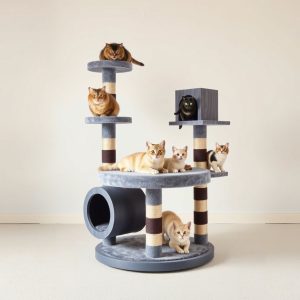
A spinning platform adds play and exercise to the cat tree.
Materials:
-
Wooden board for base
-
Lazy Susan bearing or turntable
-
Wooden posts and platforms
-
Carpet or fabric
-
Screws and nails
Steps:
-
Attach the turntable to the wooden base securely.
-
Build vertical posts and platforms on top of the turntable.
-
Cover platforms with carpet for grip.
-
Make sure spinning is smooth but not too fast.
-
Add sisal rope on posts for scratching.
This tree gives cats fun movement while climbing.
10. Floating Cat Tree with Suspended Platforms
Floating platforms attach to the wall and look like they float.
Materials:
-
Wooden boards or shelves
-
Wall anchors and screws
-
Carpet or fabric
-
Sisal rope (optional)
Steps:
-
Mount shelves on the wall at different heights using strong anchors.
-
Cover shelves with carpet for grip.
-
Add sisal rope on the wall next to shelves if cats like to scratch.
-
Arrange shelves so cats can jump from one to another.
-
Place cushions or blankets on some shelves for comfort.
Floating platforms look modern and save floor space.
FAQs about DIY Cat Trees
How do I make sure my cat tree is safe?
Use strong materials. Check that screws and nails are tight. Sand rough edges. Avoid small parts that cats could swallow. Test stability before use.
What materials work best for scratching?
Sisal rope is best. It’s rough and holds up well. Carpet and wood can work but don’t last as long.
Can I use recycled materials?
Yes! Old boxes, scrap wood, and leftover fabric work well. Just clean everything well before building.
How big should a cat tree be?
Size depends on your space and how many cats you have. Cats love tall trees but also need wide platforms.
Do cats need multiple levels?
Cats enjoy climbing and watching from high places. Multiple levels add fun and exercise.
Final Thoughts
Making a cat tree at home saves money and gives cats a special place to play and rest. The 10 ideas here use easy-to-find materials and simple steps. Pick one that fits your space and your cat’s personality.
Build slowly and test for safety. Add toys or cushions for extra fun. Your cat will appreciate a new place to explore and relax.
DIY cat trees can bring joy to both you and your pet. Start today and watch your cat climb, scratch, and nap happily.
